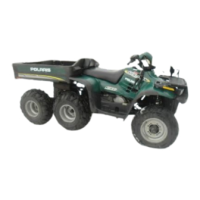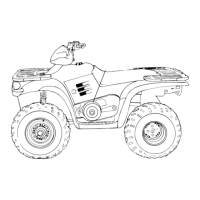ELECTRICAL
10.26
FLYWHEEL IDENTIFICATION
A
Flywheel Identification Stamp Location
The flywheel can be identified by the stamp mark in location A. Refer to “I.D.” location in chart below. Do not
use the cast mark to determine flywheel application.
Engine Application
Type Cast Stamp Comment I.D. Stamp
Sportsman 500 -- EH500PLE N/A N/A N/A 250W N/A
DC / CDI IGNITION
The Sportsman has incorporated into it’s design a DC/
CDI ignition system.
Some of the advantages of DC ignition are:
GStronger, more consistent spark at low
rpm for better performance
GEasier starts
GSimpler component design for ease of
trouble shooting and maintenance
Operation Overview:
The DC/CDI system relies on battery power for ignition.
Instead of generating DC voltage via magnetic
induction, a 12 volt DC current is supplied directly to the
CDI unit from the battery.
At the CDI, 12 volt DC current charges an internal
capacitor to build up the initial ignition charge. A small
A/C signal from the Trigger (Pulse) coil closes a
thyristor (located in the CDI) at a point
pre--determined in the crankshaft rotation by magnets
on the flywheel’s outer diameter. This signal releases
the electrical charge which saturates the coil for
ignition. DC/CDI systems have the ability to ignite
with as little as 6 volts of power.
NOTICE: Do not remove the wiring
harness from the CDI box while the key
switch is on or while the engine is
running. Damage to the CDI box may
occur!
Maximum Timing
NOTE:
DC/CDI systems and compo-
nents are not interchangeable
with any other system.

